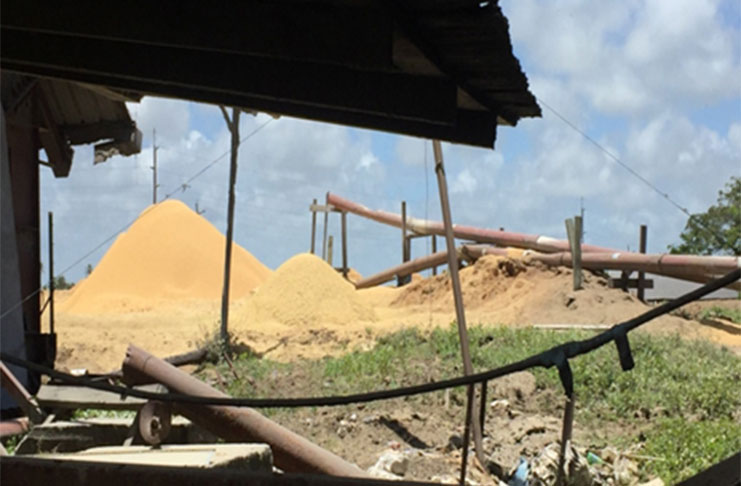GUYANA can produce 185,696.44 megawatts of energy from rice husk annually
IMAGINE all of the vehicles in this country being powered by fuels that are produced from a renewable source. Imagine that the burning of these fuels does not contribute to global climate change. Imagine that these fuels are produced in Guyana, generating jobs and revenue—that is the promise of bioenergy.
Bioenergy is the use of biological resources including plants, algae, marine life, fungi and micro-organisms, for producing renewable energy (including biofuel).
Having recognised the impact bioenergy would have on the country, the National Agricultural Research and Extension Institute (NAREI)’s Chief Executive Officer, Dr. Oudho Homenauth and Clairmont Clementson, both Research Scientists conducted a research.
The study, which was aided by Research Assistants, Lalita Gopaul and Vickram Persaud, was done early this year and centered on the investigation of Bioenergy utilisation in Guyana,including environmental and economic impacts.
The bioenergy sources identified in Guyana are rice husk from rice production, residues from the forestry industry, biodiesel from palm oil, cogeneration of bagasse, bioethanol from the molasses and biogas from cattle manure, sewage sludge, and urban and suburban waste.
The research scientists found that the use of bioenergy can slow the process of climate change by lowering the net release of greenhouse gases into the atmosphere and reduce the cost of energy, therefore, providing a plausible solution to the twin challenges of energy security and climate change mitigation.
According to the report, “The climate, soil and topography are suitable for agriculture; hence utilising agricultural biomass waste for energy production can be feasible.”
Additionally, with rice and sugar cane being the most dominant agricultural crops in Guyana, utilising wastes from these two industries could help in reducing solid waste while at the same time producing clean energy.

ENERGY FROM RICE PRODUCTION
It was found that rice husk, which is collected from the milling of paddy, contains 35 percent organic carbon and has calorific value of 3000 kilocalorie/ kilogrammes and can be used to generate fuel, heat or electricity through thermal, chemical or biological process.
In 2014, rice production was 683,516 tonnes, providing an average of 368,047 tonnes of rice husk as waste. Gasification is one of the cleanest, most efficient methods known for the conversion of rice husk biomass to electricity.
The gasification process involves burning at high temperatures in the absence of oxygen thereby reducing the amount of carbon released into the atmosphere. Gasification of 220 kilogrammes of rice husk of negligible moisture can produce 93-129 kilowatt of power.
Therefore, from annual rice production, Guyana can produce an average of 185,696.44 megawatts of energy, cutting the country’s annual diesel requirement by 109,813 barrels if all rice wastes are efficiently converted into energy.
Currently, a number of mills burn approximately 65 percent of their rice husk to generate heat for drying of paddy while about 35 percent of their rice husk ,together with the char from burning is being dumped in open spaces surrounding the mills, causing environmental threats to surrounding communities.
According to the local researchers,while the use of rice husk can provide energy to cater for some of the milling energy demands, millers are unable to fund the initially high investment. Millers noted that if support is available they would be willing to pursue waste to energy initiatives.
It was found that the unwillingness of some operators to adopt clean energy method is due to the lack of awareness of the benefits of using their waste to produce energy. Upon implementation of a gasification plant, there would be a need for specifically, skilled labour to operate and maintain the plant’s operations.
The Guyana Rice Development Board (GRDB) and the Guyana Energy Agency (GEA) will play a major role in educating operators on the benefits of using bioenergy.
The researchers indicated that the Chief Research Scientist and the Head of the Value-Added Department at GRDB indicated that more rice mills would soon be able to benefit from gasification plants through collaboration with The Energy Institute of India (TERI) and Energy Efficient Solutions Limited (EESL).
TERI would provide technical support, including training for rice mills staffers who are willing to adopt gasification systems, while EESL will provide financial aid.
Some millers are willing to invest in gasification plants since disposing of their rice husk is proving problematic. Currently, the country’s only rice husk gasification plant is operated by the Ramlakhan and Sons’ Rice Mill at Exmouth, Essequibo Coast.
This plant utilises rice husk from their milling process to power 70 percent of their internal operations. The mill funded the investment and received technical support from TERI. The Foreign Energy Institute is also working along with another operator to make waste to energy a reality.




.jpg)










